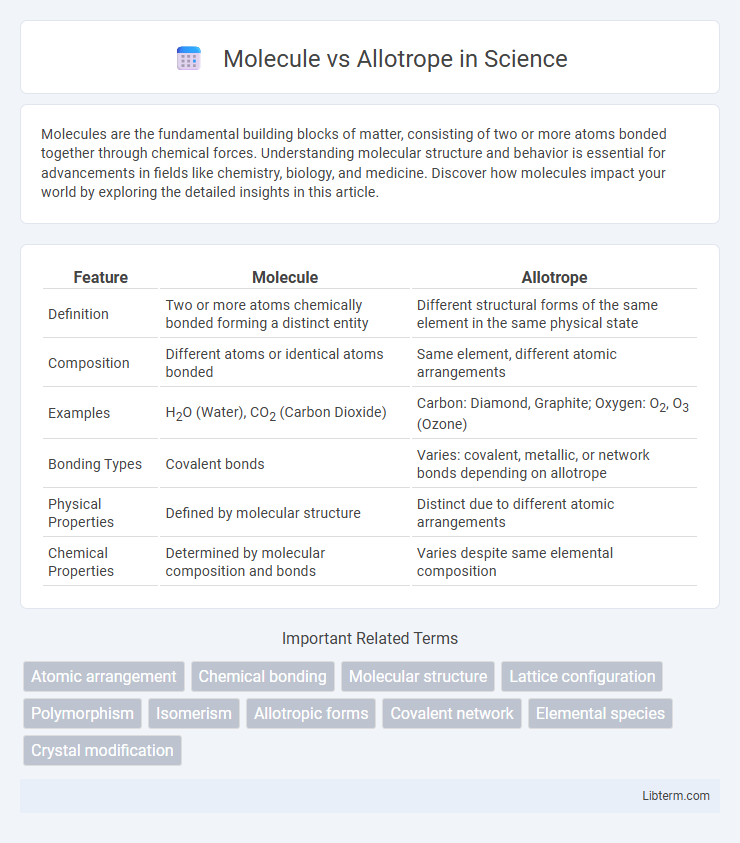Molecules are the fundamental building blocks of matter, consisting of two or more atoms bonded together through chemical forces. Understanding molecular structure and behavior is essential for advancements in fields like chemistry, biology, and medicine. Discover how molecules impact your world by exploring the detailed insights in this article.
Table of Comparison
| Feature | Molecule | Allotrope |
|---|---|---|
| Definition | Two or more atoms chemically bonded forming a distinct entity | Different structural forms of the same element in the same physical state |
| Composition | Different atoms or identical atoms bonded | Same element, different atomic arrangements |
| Examples | H2O (Water), CO2 (Carbon Dioxide) | Carbon: Diamond, Graphite; Oxygen: O2, O3 (Ozone) |
| Bonding Types | Covalent bonds | Varies: covalent, metallic, or network bonds depending on allotrope |
| Physical Properties | Defined by molecular structure | Distinct due to different atomic arrangements |
| Chemical Properties | Determined by molecular composition and bonds | Varies despite same elemental composition |
Introduction to Molecules and Allotropes
Molecules are stable groups of two or more atoms chemically bonded together, representing the smallest unit of a compound that retains its chemical properties. Allotropes are different structural forms of the same element, characterized by variations in the arrangement of atoms within the molecule, resulting in distinct physical and chemical properties. Common examples include oxygen allotropes O2 (dioxygen) and O3 (ozone), demonstrating how atomic connectivity influences molecular behavior.
Defining Molecules: Structure and Characteristics
Molecules consist of two or more atoms chemically bonded together, forming a distinct structural unit with specific geometric arrangements and defined chemical properties. Each molecule exhibits a fixed composition and molecular formula, with covalent bonds determining the shape, stability, and reactivity of the substance. The precise atomic connectivity within molecules influences their physical states and interaction patterns, differentiating them from other atomic groupings like allotropes.
What Are Allotropes? Key Features and Examples
Allotropes are different structural forms of the same element, where atoms are bonded together in distinct arrangements, resulting in varied physical and chemical properties. Key features of allotropes include variations in molecular geometry, bonding patterns, and stability, which influence characteristics such as hardness, conductivity, and color. Common examples of allotropes include carbon allotropes like diamond, graphite, and graphene, as well as oxygen allotropes such as O2 (dioxygen) and O3 (ozone).
Fundamental Differences Between Molecules and Allotropes
Molecules consist of two or more atoms chemically bonded together representing the smallest unit of a compound, while allotropes are different structural forms of the same element exhibiting distinct physical and chemical properties. The fundamental difference lies in molecules being defined by their atomic combinations, whereas allotropes differ only in the arrangement of atoms within the elemental form. Examples include oxygen molecules (O2) as a molecule and oxygen allotropes like ozone (O3), highlighting variations in molecular structure and elemental forms.
Chemical Bonding in Molecules vs. Allotropes
Molecules consist of atoms bonded together through strong covalent or ionic chemical bonds, resulting in distinct, stable units with defined molecular formulas. Allotropes arise from variations in the bonding patterns of the same element, such as carbon forming diamond through a three-dimensional network of covalent bonds or graphite via layered planar bonds with weaker van der Waals forces between layers. The key difference lies in molecules having discrete chemical bonds creating individual entities, whereas allotropes exhibit extended bonding networks forming different structural phases of an element.
Common Examples: Molecules in Everyday Life
Water (H2O), oxygen (O2), and carbon dioxide (CO2) are common molecular examples essential for life and environmental processes. Molecules consist of atoms chemically bonded in fixed ratios, unlike allotropes, which are different structural forms of the same element, such as carbon allotropes graphite and diamond. Everyday molecules like glucose (C6H12O6) power cellular energy, demonstrating the molecular diversity crucial to biological functions.
Notable Allotropes: Carbon, Oxygen, and More
Notable allotropes exhibit unique structural forms of elements with distinct physical and chemical properties; for example, carbon's allotropes include diamond, graphite, and graphene, each varying in hardness, conductivity, and atomic arrangement. Oxygen exists primarily as dioxygen (O2) and ozone (O3), with ozone playing a critical role in UV radiation absorption in the Earth's atmosphere. Other elements like phosphorus and sulfur also show remarkable allotropes, displaying diverse bonding patterns that influence reactivity and stability in various industrial and environmental processes.
Physical Properties Comparison
Molecules consist of two or more atoms chemically bonded, exhibiting distinct physical properties such as melting point, boiling point, and solubility based on their molecular structure and intermolecular forces. Allotropes are different physical forms of the same element, like carbon's diamond, graphite, and graphene, each displaying unique hardness, electrical conductivity, and density due to variations in atomic arrangement. Comparing physical properties reveals that molecular compounds typically have consistent properties within each compound, while allotropes show dramatic differences arising from structural changes in the elemental composition.
Importance in Chemistry and Material Science
Molecules are fundamental units of chemical compounds consisting of atoms bonded together, essential for understanding chemical reactions and properties at the molecular level. Allotropes represent different structural forms of the same element, such as carbon's diamond and graphite, demonstrating how atomic arrangement influences material properties. The study of molecules and allotropes is crucial for advancing material science, enabling the design of new substances with tailored mechanical, electrical, and chemical characteristics.
Conclusion: Molecule vs Allotrope—Key Takeaways
Molecules are groups of atoms bonded together representing the smallest unit of a chemical compound, while allotropes are different structural forms of the same element in the same physical state. Understanding the distinction highlights that molecules involve chemical bonding between different or same atoms, whereas allotropes derive from variations in atomic arrangements of a single element. This fundamental difference is crucial for applications in chemistry, materials science, and nanotechnology.
Molecule Infographic

 libterm.com
libterm.com